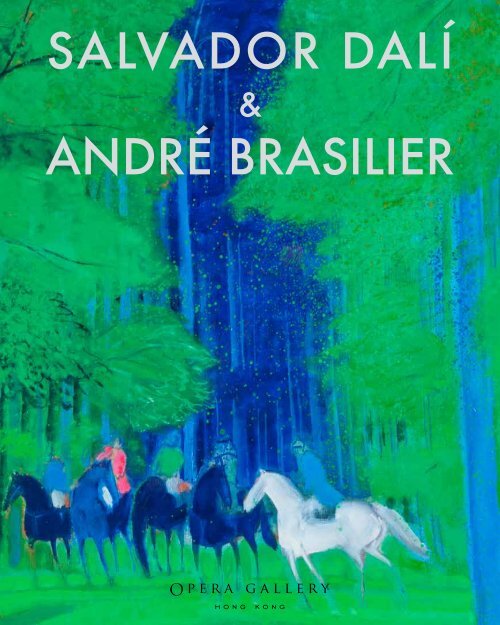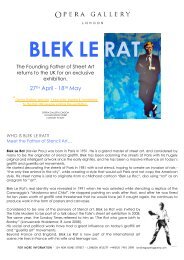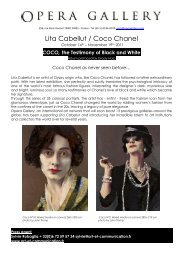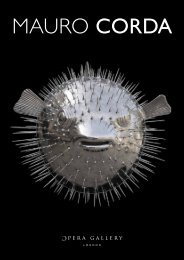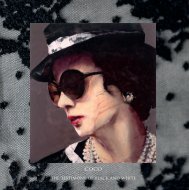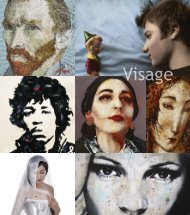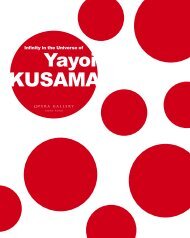SALVADOR DALÍ ANDRÉ BRASILIER - Opera Gallery
SALVADOR DALÍ ANDRÉ BRASILIER - Opera Gallery
SALVADOR DALÍ ANDRÉ BRASILIER - Opera Gallery
You also want an ePaper? Increase the reach of your titles
YUMPU automatically turns print PDFs into web optimized ePapers that Google loves.
<strong>SALVADOR</strong> <strong>DALÍ</strong><br />
&<br />
<strong>ANDRÉ</strong> <strong>BRASILIER</strong>
The Salvador Dalí Treasures & The Universe of André Brasilier<br />
Welcoming the New Year, <strong>Opera</strong> <strong>Gallery</strong> presents a spectacular dual exhibition; from figures of the surreal<br />
subconscious world to the expressionist strokes of landscapes and wild horses, featuring exquisite Salvador<br />
Dalí jewelled sculptures in limited edition along side a staggering series of oil paintings by French artist André<br />
Brasilier.<br />
The Salvador Dalí Jewelled Sculpture Collection<br />
In collaboration with The Dalí Universe, <strong>Opera</strong> <strong>Gallery</strong> is proud to present this unique and stunning collection<br />
that makes its debut visit in Hong Kong. The pieces, made from 18 carat gold, embedded with precious<br />
gemstones, amongst them diamonds, rubies, sapphires and emeralds mounted on a bed of solid crystal rock,<br />
represent an exquisite collaboration between the jewellery and the art worlds. Dalí was always attracted to<br />
precious gold, unusual gemstone and their rare attributes, using them in many of his sculptural creations. His<br />
aim was to present jewel as art, emphasizing their design and craftsmanship stating:<br />
‘In jewel as in all my art, I create what I love.’<br />
This precious collection consists of ten figures from Dalí’s most important and famous iconic creations including<br />
Profile of Time and Alice in Wonderland. Each creation is in limited edition of only 12 pieces and sized 8-15 cm<br />
making these miniature beauties a truly exceptional sight for Dali’s fans.<br />
Apart from the jewel collection the gallery will showcase the Dalí Universal Tarot collection. Dalí assembled<br />
and painted close to 100 collages of Tarot cards in his unique surrealist vision and on display will be highlights<br />
in gouache and mixed media, an incredible sight for historians, art lovers, and Dalí collectors.<br />
André Brasilier Oil Paintings<br />
From his early beginnings in the 1950s, in École des Beaux-Arts to his international recognition triumphed<br />
with a major retrospective exhibition in Saint-Pétersbourg Hermitage Museum in 2005, André Brasilier is<br />
among the most important expressionist artists alive in France these days.<br />
For his first Hong Kong showing, the gallery has curated a special selection of Brasilier dreamy paintings<br />
including his most notable themes illustrating horses, beautiful ladies, and landscapes depicting his love for<br />
music and nature. Horses in particular, play muse to Brasilier, as he loves their beauty and the harmony they<br />
have with nature. In every painting displayed in this show, one can feel the serenity, balance, and the liveliness<br />
of the subject, bringing whimsical allure to the surface of the works. These magical compositions won Brasilier<br />
numerous awards throughout the years and positioned him as a highly collectable artist in French art circles.<br />
We are delighted to bring you this festive collection and send you warm wishes for a happy new year full of<br />
colors and great art!<br />
Gilles DYAN<br />
Chairman & Founder<br />
<strong>Opera</strong> <strong>Gallery</strong> Group<br />
Shirley YABLONSKY<br />
Director<br />
<strong>Opera</strong> <strong>Gallery</strong> Hong Kong
<strong>SALVADOR</strong> <strong>DALÍ</strong><br />
Salvador Dalí was born on May 11, 1904, in Figueres, near Barcelona, Spain and is considered among the greatest<br />
surrealist painters of the 20th century.<br />
The son of Salvador and Felipa Dome, Dalí was an intelligent child, producing advanced drawings at an early age.<br />
His father enrolled him at the Hispano-French School of the Immaculate Conception in Figueres, where he learned<br />
French, the language that was to become his cultural vehicle. By 1920 he convinced his father that he could make a<br />
living as an artist and was allowed to go to Madrid, Spain, to study painting. At the time he was strongly influenced<br />
by the dreamlike works of the Italian painter Giorgio de Chirico as well as classical painters Raphaël, Vermeer and<br />
Velázquez, the last inspired him in more than one way including adopting a flamboyant moustache, one that became<br />
Dalí’s iconic symbol.<br />
Dalí’s own style began to show itself at the early 1920’s; he would draw, in an extremely precise manner, the strange<br />
subjects of his dream world. His personal style showed a number of influences, strongest among which was his<br />
contact with surrealism. In 1929 he travelled to Paris and through Joan Miró came into contact with the group of<br />
surrealists headed by André Breton. Producing many of his legendary pieces between 1929 and 1939, Dalí’s paintings<br />
incorporated a growing fascination with history, religion, and science. In the early 1930’s many of the surrealists began<br />
to break away from the movement, feeling that direct political action had to come before any artistic revolutions. Dalí<br />
put forth his ‘Paranoiac-critical method’ accessing the subconscious for greater artistic creativity as a way to avoid<br />
having to politically conquer the world.<br />
A key event in Dalí’s life during this time was meeting his wife, Gala, who was at that time married to another surrealist<br />
called Paul Eluard. She became his main influence and muse, both in his personal life as in many of his paintings.<br />
In 1936 ‘Time’ magazine devoted its cover to Dalí’s picture taken by Man Ray, Dalí was only 32 at the time.<br />
Dalí’s career was extremely versatile and successful over the next fifty some years and included the creation of<br />
gigantic paintings as well as writing, sculptures, theater, fashion and films.<br />
Between 1941 and 1970 Dalí created an ensemble of 39 jewels made of gold and encrusted with rubies, diamonds,<br />
and emeralds. Dalí commented once: ‘Without an audience, without the presence of spectators, these jewels would<br />
not fulfill the function for which they came into being. The viewer, then, is the ultimate artist’.<br />
Dalí past away on January 23, 1989, in Figueres, Spain and is remembered as one of the most prolific artists of the<br />
20 th century yet his fantastic imagery and flamboyant personality also made him one of the best-known.<br />
Photo credits: © I.A.R Art Resources<br />
Photo credit: © François Petit
<strong>SALVADOR</strong> <strong>DALÍ</strong><br />
Jewelled Sculptures
ALICE IN WONDERLAND<br />
Conceived in 1977, created in 2008, edition of 12<br />
Inscribed ‘Dalí’<br />
Material: 18 karat gold<br />
Gemstones: 1269 diamonds, 15.09 karat<br />
10 rubies, 0.18 karat<br />
Base: rock crystal<br />
H: 10.5 cm - 4.1 in.<br />
Like Alice in Wonderland, Dalí travelled a long and arduous road through the land of dreams, by<br />
means of his artistic expression. The artist was clearly drawn to both the incredible story-line and<br />
the extravagant characters in this intoxicating fairytale. Alice is one of Dalí’s favorite images. She is<br />
the eternal girl-child who responds to the confusion of the world behind the looking glass with the<br />
irrefutable naivety of childhood. After all her meetings with the inhabitants of this fantastic world,<br />
she returns to reality not only unharmed but unchanged by her surrealistic experience. Looking at<br />
Dalí’s sculpture we see that Alice’s jump rope has become a twisted cord symbolizing everyday life.<br />
Her hands and hair have blossomed into roses symbolizing feminine beauty and eternal youth. The<br />
Grecian drapes of her dress symbolize antiquity and the beauty that is respected throughout the ages.<br />
8
DALINIAN DANCER<br />
Conceived in 1949, created in 2008, edition of 12<br />
Inscribed ‘Dalí’<br />
Material: 18 karat gold<br />
Gemstones: 461 diamonds, 13.13 karat<br />
23 rubies, 0.80 karat<br />
Base: rock crystal<br />
H: 10.4 cm - 4.1 in.<br />
Inspired by her own inner force, this vibrant dancer moves to the intense and passionate rhythms<br />
of the Spanish flamenco. Dalí was fascinated with the art and spirit of dance, especially that of the<br />
flamenco, emblematic of his homeland, and known for exploring the full range of human emotions.<br />
The dancer’s skirts twirl around her in a spontaneous display of vitality and ecstasy.<br />
10
DANCE OF TIME II<br />
Conceived in 1979, created in 2008, edition of 12<br />
Inscribed ‘Dalí’<br />
Material: 18 karat gold<br />
Gemstones: 404 diamonds, 9,32 karat<br />
235 rubies, 8,33 karat<br />
Base: rock crystal<br />
H: 8 cm - 3.1 in.<br />
The melted watch is the most well-known and beloved of Dalí’s iconoclastic images - the artist chose<br />
to portray this image consistently throughout his lifetime, beginning in 1931. The ever-present fluidity<br />
of time is represented in this sculpture as time not only moving, but dancing in rhythm to the beat<br />
of the universe. Universal time knows no limits; it must be remembered that time, as we understand<br />
it, is a human notion. Instead, Dalínian time is perpetual and ‘dances on’ stopping for no man,<br />
history or even the cosmos. The image depicts Dalí’s fantastical relationship with time, his perception<br />
of its constricting limitations and the importance he believed to be inherent in memory. This image<br />
is depicted in three different forms: Dance of Time I,II and III.<br />
12
LADY GODIVA<br />
Conceived in 1976, created in 2008, edition of 12<br />
Inscribed ‘Dalí’<br />
Material: 18 karat gold<br />
Gemstones: 1348 diamonds, 36.05 karat<br />
20 rubies, 0.37 karat<br />
61 sapphires, 1.21 karat<br />
Base: rock crystal<br />
H: 11 cm - 4.3 in.<br />
Dalí, the great Surrealist master, selected the image of Lady Godiva as one of his favourites, and<br />
pays homage to her sensuous and shapely female form through the conception of this sculpture.<br />
Announcing her arrival, butterflies not only hover around her and her noble steed, but also adorn her<br />
body as she plays her trumpet. Lady Godiva embodies earthly beauty, whereas the butterflies depict<br />
the ethereal otherworld.<br />
14
PROFILE OF TIME<br />
Conceived in 1977, created in 2008, edition of 12<br />
Inscribed ‘Dalí’<br />
Material: 18 karat gold<br />
Gemstones: 442 diamonds, 5.88 karat<br />
1 ruby, 0.12 karat<br />
Base: rock crystal<br />
H: 12.5 cm - 4.9 in.<br />
This sculpture echoes Dalí’s famous 1931 painting The Persistence of Memory in which the famous<br />
melted watch appeared for the first time. As the watch liquefies over the tree, it forms into a human<br />
profile, underlining the interminable relationship between man and time. The unexpected softness<br />
of the watch also represents the psychological aspect whereby time, whilst considered to be precise<br />
and fixed in its nature, can, in fact, vary significantly in human perception. All men must bend to<br />
the passing of time. We see Dalí’s profile in the face of the clock. There is a tear falling from his eye,<br />
lamenting the path of life that all men must travel.<br />
16
SPACE VENUS<br />
Conceived in 1977, created in 2008, edition of 12<br />
Inscribed ‘Dalí’<br />
Material: 18 karat gold<br />
Gemstones: 1981 diamonds, 59.05 karat<br />
Base: rock crystal<br />
H: 11 cm - 4.3 in.<br />
Venus is the goddess of beauty, and Dalí pays homage to the female figure by adding his own special<br />
elements. The underlying form in this sculpture is of a classic marble statue of a female torso, to<br />
which have been added four Dalinian elements: a soft watch, an egg, two ants and a separation of the<br />
body into two parts. The watch is draped over the neck to give us two opposing messages; that beauty<br />
of the flesh is temporary and will vanish, while beauty of art is timeless and eternal. The ants are reminders<br />
of human mortality and impermanence. The Space Venus is divided into two parts to reveal<br />
the egg, which like the ant, is a favourite Dalínian theme given the duality of its hard exterior and soft<br />
interior. The egg is a positive symbol and represents life, renewal, continuation and the future.<br />
18
SURREALIST PIANO<br />
Conceived in 1954, created in 2008, edition of 12<br />
Inscribed ‘Dalí’<br />
Material: 18 karat gold<br />
Gemstones: 726 diamonds, 25.89 karat, 6 diamonds baguette<br />
12 sapphires baguette, 2.42 karat<br />
Base: rock crystal<br />
H: 8 cm - 3.1 in.<br />
The Surrealist Piano is one of Dalí’s major iconoclastic symbols. The artist has chosen to transform<br />
the banal wooden legs of a piano, replacing them with dancing female legs, thus creating an animate,<br />
joyous instrument that can dance as well as play. Dalí often blurred the lines between the real and<br />
surreal worlds, taking an inert and lifeless object, and, with a wave of his magic surrealist wand,<br />
created an entirely new fantasmagorical happening.<br />
20
TRIUMPHANT ELEPHANT<br />
Conceived in 1975, created in 2008, edition of 12<br />
Inscribed ‘Dalí’<br />
Material: 18 karat gold<br />
Gemstones: 143 diamonds, 4.56 karat<br />
25 rubies, 1.44 karat<br />
Base: rock crystal<br />
H: 15.5 cm - 6.1 in.<br />
The elephant, Dalí’s iconoclastic symbol of the future and one of his favourite images, is often depicted<br />
atop mosquito-like legs, emphasising the contrast between robustness and fragility, much<br />
like the contrast between the past and modernity. The animal’s jewelled saddle symbolises wealth,<br />
and the dawn of a new era is announced by a flying angel, trumpeting success and prosperity. Dalí’s<br />
elephant exemplifies every individual’s hope for abundance and good fortune in the future.<br />
22
UNICORN<br />
Conceived in 1977, created in 2008, edition of 12<br />
Inscribed ‘Dalí’<br />
Material: 18 karat gold<br />
Gemstones: 2326 diamonds, 31.34 karat<br />
20 rubies, 0.64 karat<br />
2 sapphires, 0.04 karat<br />
Base: rock crystal<br />
H: 12 cm - 4.7 in.<br />
The unicorn is a mythical creature prominent in legends as an intricately linked symbol of purity. The<br />
horn of a unicorn is believed capable of neutralizing any poison. This animal also has connotations of<br />
chastity and virginity, both male and female, and was adopted as the sign or ideal representation of<br />
the ‘perfect’ knight. In some legends it was also a symbol of virility. Dalí chose to portray the unicorn<br />
as a phallic figure whose horn penetrates a stone wall through a heart-shaped opening, from which<br />
a drop of blood seems to be slowly falling. The nude, reposing female stretched out in the foreground<br />
at the hooves of the animal underlines the sensual nature of this sculpture.<br />
24
<strong>SALVADOR</strong> <strong>DALÍ</strong><br />
Sculptures
DANCE OF TIME II<br />
Conceived in 1979, first cast in 1984<br />
This cast at a later date<br />
Inscribed ‘Dalí’<br />
Bronze, edition of 8 + 4 EA + 2 EF<br />
H: 150 cm – 59.1 in.<br />
The melted watch is the most well-known and beloved of Dalí’s iconoclastic images - the artist chose to portray this<br />
image consistently throughout his lifetime, beginning in 1931. The ever-present fluidity of time is represented in this<br />
sculpture as time not only moving, but dancing in rhythm to the beat of the universe. Universal time knows no limits; it<br />
must be remembered that time, as we understand it, is a human notion. Instead, Dalínian time is perpetual and ‘dances<br />
on’ stopping for no man, history or even the cosmos. The image depicts Dalí’s fantastical relationship with time,<br />
his perception of its constricting limitations and the importance he believed to be inherent in memory. This image is<br />
depicted in three different forms: Dance of Time I,II and III.<br />
28
PROFILE OF TIME<br />
Conceived in 1977, first cast in 1984<br />
This cast at a later date<br />
Inscribed ‘Dalí’<br />
Bronze, green patina, edition of 350 + 35 EA<br />
H: 51 cm – 20.1 in.<br />
This sculpture echoes Dalí’s famous 1931 painting The Persistence of Memory in which the famous<br />
melted watch appeared for the first time. As the watch liquefies over the tree, it forms into a human<br />
profile, underlining the interminable relationship between man and time. The unexpected softness<br />
of the watch also represents the psychological aspect whereby time, whilst considered to be precise<br />
and fixed in its nature, can, in fact, vary significantly in human perception. All men must bend to<br />
the passing of time. We see Dalí’s profile in the face of the clock. There is a tear falling from his eye,<br />
lamenting the path of life that all men must travel.<br />
DANCE OF TIME III<br />
Conceived in 1979, first cast in 1984<br />
This cast at a later date<br />
Inscribed ‘Dalí’<br />
Bronze, green/gold patina, edition of 350 + 35 EA<br />
H: 26,5 cm – 10.4 in.<br />
The melted watch is the most well-known and beloved of Dalí’s iconoclastic images - the artist chose<br />
to portray this image consistently throughout his lifetime, beginning in 1931. The ever-present fluidity<br />
of time is represented in this sculpture as time not only moving, but dancing in rhythm to the beat of<br />
the universe. Universal time knows no limits; it must be remembered that time, as we understand it,<br />
is a human notion. Instead, Dalínian time is perpetual and ‘dances on’ stopping for no man, history<br />
or even the cosmos. The image depicts Dalí’s fantastical relationship with time, his perception of its<br />
constricting limitations and the importance he believed to be inherent in memory. This image is depicted<br />
in three different forms: Dance of Time I,II and III.<br />
30 31
DANCE OF TIME I<br />
Conceived in 1979, first cast in 1984<br />
This cast at a later date<br />
Inscribed ‘Dalí’<br />
Bronze, green/gold patina, edition of 350 + 35 EA<br />
H: 38,5 cm – 15.2 in.<br />
DANCE OF TIME II<br />
Conceived in 1979, first cast in 1984<br />
This cast at a later date<br />
Inscribed ‘Dalí’<br />
Bronze, green/gold patina, edition of 350 + 35 EA<br />
H: 30,5 cm – 12 in.<br />
The melted watch is the most well-known and beloved of Dalí’s iconoclastic images - the artist chose<br />
to portray this image consistently throughout his lifetime, beginning in 1931. The ever-present fluidity<br />
of time is represented in this sculpture as time not only moving, but dancing in rhythm to the beat of<br />
the universe. Universal time knows no limits; it must be remembered that time, as we understand it,<br />
is a human notion. Instead, Dalínian time is perpetual and ‘dances on’ stopping for no man, history<br />
or even the cosmos. The image depicts Dalí’s fantastical relationship with time, his perception of its<br />
constricting limitations and the importance he believed to be inherent in memory. This image is depicted<br />
in three different forms: Dance of Time I,II and III.<br />
The melted watch is the most well-known and beloved of Dalí’s iconoclastic images - the artist chose<br />
to portray this image consistently throughout his lifetime, beginning in 1931. The ever-present fluidity<br />
of time is represented in this sculpture as time not only moving, but dancing in rhythm to the beat of<br />
the universe. Universal time knows no limits; it must be remembered that time, as we understand it,<br />
is a human notion. Instead, Dalínian time is perpetual and ‘dances on’ stopping for no man, history<br />
or even the cosmos. The image depicts Dalí’s fantastical relationship with time, his perception of its<br />
constricting limitations and the importance he believed to be inherent in memory. This image is depicted<br />
in three different forms: Dance of Time I,II and III.<br />
32 33
TRIUMPHANT ELEPHANT<br />
Conceived in 1975, first cast in 1984<br />
This cast at a later date<br />
Inscribed ‘Dalí’<br />
Bronze, green patina, edition of 350 + 35 EA<br />
H: 53 cm – 20.9 in.<br />
The elephant, Dalí’s iconoclastic symbol of the future and one of his favourite images, is often depicted<br />
atop mosquito-like legs, emphasising the contrast between robustness and fragility, much<br />
like the contrast between the past and modernity. The animal’s jewelled saddle symbolises wealth,<br />
and the dawn of a new era is announced by a flying angel, trumpeting success and prosperity. Dalí’s<br />
elephant exemplifies every individual’s hope for abundance and good fortune in the future.<br />
SPACE ELEPHANT<br />
Conceived and first cast in 1980<br />
This cast at a later date<br />
Inscribed ‘Dalí’<br />
Bronze, blue patina, edition of 350 + 35 EA<br />
H: 94 cm – 37 in.<br />
The Space Elephant embodies the Dalinian symbol that was born in 1946 when the artist painted<br />
one of his most famous pictures The Temptation of St. Anthony. Dalí created the image of an<br />
elephant in the Egyptian desert carrying an obelisk, a symbol of the presence and progress of<br />
technology in the modern world. Four elephants stand on spider-like legs of desire, and offer art,<br />
beauty, power, pleasure and knowledge. For this sculpture, based on the elephants in the painting,<br />
Dalí maintains the almost invisible spindle-like legs emphasizing the contrast between robustness<br />
and fragility, and contrasting the idea of weightlessness with structure. This fantastically surreal<br />
creature, moving through space towards the heavens, symbolizes a flight of fantasy to a mesmerizing<br />
and surrealistic universe.<br />
34<br />
35
WOMAN OF TIME<br />
Conceived in 1973, first cast in 1984<br />
This cast at a later date<br />
Inscribed ‘Dalí’<br />
Bronze, green patina, edition of 350 + 35 EA<br />
H: 65,5 cm – 25.8 in.<br />
LADY GODIVA WITH BUTTERFLIES<br />
Conceived in 1976, first cast in 1984<br />
This cast at a later date<br />
Inscribed ‘Dalí’<br />
Bronze, brown patina, edition of 350 + 35 EA<br />
H: 51 cm – 20.1 in.<br />
Holding a perfectly formed flower and dressed in gently flowing robes, this radiant young woman<br />
bears Dalí’s most famous symbol… the melting watch, which hints at the human construction of the<br />
nature of time. The artist allows the watch to pose the question - is beauty dependent on time, or<br />
is it eternal? The clock alludes to the woman’s awareness that beauty can be independent of time,<br />
whether it is corporeal grace or an ethereal rose.<br />
Dalí, the great Surrealist master, selected the image of Lady Godiva as one of his favourites, and<br />
pays homage to her sensuous and shapely female form through the conception of this sculpture.<br />
Announcing her arrival, butterflies not only hover around her and her noble steed, but also adorn<br />
her body as she plays her trumpet. Lady Godiva embodies earthly beauty, whereas the butterflies<br />
depict the ethereal otherworld.<br />
36 37
ALICE IN WONDERLAND<br />
Conceived in 1977, first cast in 1984<br />
This cast at a later date<br />
Inscribed ‘Dalí’<br />
Bronze, blue patina, edition of 350 + 35 EA<br />
H: 90,5 cm – 35.6 in.<br />
Like Alice in Wonderland, Dalí travelled a long and arduous road through the land of dreams, by<br />
means of his artistic expression. The artist was clearly drawn to both the incredible story-line and<br />
the extravagant characters in this intoxicating fairytale. Alice is one of Dalí’s favorite images. She is<br />
the eternal girl-child who responds to the confusion of the world behind the looking glass with the<br />
irrefutable naivety of childhood. After all her meetings with the inhabitants of this fantastic world,<br />
she returns to reality not only unharmed but unchanged by her surrealistic experience. Looking at<br />
Dalí’s sculpture we see that Alice’s jump rope has become a twisted cord symbolizing everyday life.<br />
Her hands and hair have blossomed into roses symbolizing feminine beauty and eternal youth. The<br />
Grecian drapes of her dress symbolize antiquity and the beauty that is respected throughout the ages.<br />
DALINIAN DANCER<br />
Conceived in 1949, first cast in 1984<br />
This cast at a later date<br />
Inscribed ‘Dalí’<br />
Bronze, blue patina, edition of 350 + 35 EA<br />
H: 40,5 cm – 15.9 in.<br />
Inspired by her own inner force, this vibrant dancer moves to the intense and passionate rhythms<br />
of the Spanish flamenco. Dalí was fascinated with the art and spirit of dance, especially that of the<br />
flamenco, emblematic of his homeland, and known for exploring the full range of human emotions.<br />
The dancer’s skirts twirl around her in a spontaneous display of vitality and ecstasy.<br />
38 39
MAN WITH BUTTERFLY<br />
Conceived in 1968, first cast in 1984<br />
This cast at a later date<br />
Inscribed ‘Dalí’<br />
Bronze, black/green patina, edition of 350 + 35 EA<br />
H: 55,5 cm – 21.8 in.<br />
This image of this elegant sculpture was originally designed as part of the Dalí’s famous Tarot series,<br />
which was created specifically for his wife and muse, Gala. The figure of Man with Butterfly leaves<br />
the banality of the everyday grounded world for that of the butterfly, which, being lighter, will give the<br />
man wings and help him soar to a different physical plane - one where he can shed daily worries and<br />
habitual restraint.<br />
WOMAN AFLAME<br />
Conceived and first cast in 1980<br />
This cast at a later date<br />
Inscribed ‘Dalí’<br />
Bronze, green patina, edition of 350 + 35 EA<br />
H: 84 cm – 33.1 in.<br />
This sculpture unites two of Dalí’s obsessions: fire, and a female figure with drawers. The flames<br />
seem to have a life of their own, and represent the hidden intensity of unconscious desire, while<br />
the drawers represent the mystery of hidden secrets. This beautiful faceless woman symbolizes all<br />
women. For Dali, a woman’s mystery is her true beauty.<br />
40 41
SPACE VENUS<br />
Conceived in 1977, first cast in 1984<br />
This cast at a later date<br />
Inscribed ‘Dalí’<br />
Bronze, green patina, edition of 350 + 35 EA<br />
H: 65 cm – 25.6 in.<br />
Venus is the goddess of beauty, and Dalí pays homage to the female figure by adding his own special<br />
elements. The underlying form in this sculpture is of a classic marble statue of a female torso, to<br />
which have been added four Dalinian elements: a soft watch, an egg, two ants and a separation of the<br />
body into two parts. The watch is draped over the neck to give us two opposing messages; that beauty<br />
of the flesh is temporary and will vanish, while beauty of art is timeless and eternal. The ants are reminders<br />
of human mortality and impermanence. The Space Venus is divided into two parts to reveal<br />
the egg, which like the ant, is a favourite Dalínian theme given the duality of its hard exterior and soft<br />
interior. The egg is a positive symbol and represents life, renewal, continuation and the future.<br />
ADAM AND EVE<br />
Conceived in 1968, first cast in 1984<br />
This cast at a later date<br />
Inscribed ‘Dalí’<br />
Bronze, green/black patina, edition of 350 + 35 EA<br />
H: 52 cm – 20,5 in.<br />
In one exquisite artwork, Dalí deftly portrays the Garden of Eden: Adam, Eve, and the serpent,<br />
as well as the intricate tension between the three. The artist captures the very moment Eve offers<br />
Adam the forbidden fruit - astonished, Adam raises his hand in indecision, unsure of their<br />
fate should he relinquish himself to the enticing temptation. In an attempt to comfort the doomed<br />
couple, aware of the heartache that lies ahead, the serpent coils himself in the shape of a heart,<br />
reminding Adam and Eve that love creates a whole which is greater than the sum of its individual<br />
parts.<br />
42 43
NOBILITY OF TIME<br />
Conceived in 1977, first cast in 1984<br />
This cast at a later date<br />
Inscribed ‘Dalí’<br />
Bronze, brown patina, edition of 350 + 35 EA<br />
H: 60 cm – 23.6 in.<br />
Dalí’s soft watch is both draped against and supported by the remains of a tree whose trunks sprout<br />
new life and whose roots entwine a stone. The terminology, ‘the crown of a watch’ usually indicates a<br />
mechanical device which allows us to set the hands and wind the timepiece. Time, however, according<br />
to a Dalínian watch, is changeless and cannot be set, and the watch itself has no internal power or<br />
motion. Given this absence of movement, the crown in this case is interpreted by the artist as a royal<br />
crown which adorns the watch, identifies time’s mastery over human beings rather than its utility to<br />
him. His majesty is attended by two reoccurring, fantastical Dalínian symbols: a contemplative angel,<br />
and a woman draped in shawls look on. Time reigns supreme over both art and reality.<br />
44
<strong>SALVADOR</strong> <strong>DALÍ</strong><br />
Gouaches
FIVE OF WANDS<br />
Gouache on paper<br />
30,9 x 24 cm – 12.2 x 9.4 in.<br />
TEN OF WANDS<br />
Gouache on paper<br />
30,9 x 24 cm – 12.2 x 9.4 in.<br />
Certificate<br />
Robert P. Descharnes has confirmed the authenticity of this work<br />
Certificate<br />
Robert P. Descharnes has confirmed the authenticity of this work<br />
48<br />
49
THREE OF CUPS<br />
Gouache on paper<br />
30,9 x 24 cm – 12.2 x 9.4 in.<br />
SIX OF CUPS<br />
Gouache on paper<br />
30,9 x 24 cm – 12.2 x 9.4 in.<br />
Certificate<br />
Robert P. Descharnes has confirmed the authenticity of this work<br />
Certificate<br />
Robert P. Descharnes has confirmed the authenticity of this work<br />
50<br />
51
THREE OF SWORDS<br />
Gouache on paper<br />
30,9 x 24 cm – 12.2 x 9.4 in.<br />
FIVE OF SWORDS<br />
Gouache on paper<br />
30,9 x 24 cm – 12.2 x 9.4 in.<br />
Certificate<br />
Robert P. Descharnes has confirmed the authenticity of this work<br />
Certificate<br />
Robert P. Descharnes has confirmed the authenticity of this work<br />
52<br />
53
FIVE OF PENTACLES<br />
Gouache on paper<br />
30,9 x 24 cm – 12.2 x 9.4 in.<br />
KNIGHT OF PENTACLES<br />
Gouache on paper<br />
30,9 x 24 cm – 12.2 x 9.4 in.<br />
Certificate<br />
Robert P. Descharnes has confirmed the authenticity of this work<br />
Certificate<br />
Robert P. Descharnes has confirmed the authenticity of this work<br />
54<br />
55
QUEEN OF WANDS<br />
Gouache on paper<br />
30,9 x 24 cm – 12.2 x 9.4 in.<br />
Certificate<br />
Robert P. Descharnes has confirmed the authenticity of this work<br />
56
<strong>ANDRÉ</strong> <strong>BRASILIER</strong><br />
André Brasilier was born into an artistic family in 1929 Saumur, Anjou, France and spent<br />
more than half a century creating canvasses that are a blend of abstraction, expressionism,<br />
and something distinctly his own. A multi-talented artist, Brasilier is well acquainted with<br />
the techniques of an accomplished painter, watercolorist, engraver and lithographer.<br />
His works often feature themes and motifs of horses, nature, music, and women.<br />
Enriched with his peaceful worlds filled with beautiful women and gentlemen floating<br />
through life in harmony. Set against the most simplistic and romantic backgrounds, Brasilier<br />
transports us easily into surreal landscapes, which lighten our soul with dreamy infusions of<br />
figures set in simplicity of colors, shape and form.<br />
Brasilier won the Premier Grand Prix de Rome of painting already in 1953. He had his first<br />
retrospective of 100 artworks from 1950-1980 at the Château de Chenonceau in 1980 and a<br />
Retrospective exhibition at the Musée Picasso-Château Grimaldi in Antibes (French Riviera)<br />
in 1988.Over the years he held numerous exhibitions all over the world, most notably was in<br />
2005 when he was honored by a retrospective exhibition of his work at Russia’s renowned<br />
Hermitage Museum in Saint-Pétersbourg and in 2007 in the Museum Haus Ludwig für<br />
kunstausstellungen in Germany.<br />
This exhibition includes his most notable themes, illustrating the beauty of horses and his<br />
personal love for music. Through his eyes, we see how he considers horses to be the very<br />
incarnation of beauty, with every stroke proclaiming his adoration and love. The consistent<br />
depiction of their flawless movements set against the backdrop of unforgettable landscapes<br />
and seascapes allow us to feel the grace and strength of these magnificent animals, often<br />
viewed as intrinsically linked with the very land they live on.<br />
Music, as a companion of the fine arts, is also depicted through the emotions of orchestral<br />
musicians. Brasilier clearly embraces the special relationship between the fine arts and<br />
music, and show us how they share a common vocabulary which includes tones, harmony,<br />
rhythm and energy. With his simple compositions and lively colors, Brasilier has allowed us<br />
to embrace the delicate balance of music seen through his eyes, and expressed on a canvas.
CAVALIERS SUR LA NEIGE, 2011<br />
Oil on canvas, 195 x 114 cm - 76.8 x 44.9 in.<br />
NEIGE EN TARDENOIS, 2010<br />
Oil on canvas, 73 x 100 cm - 28.7 x 39.4 in.<br />
60 61
FORÊT DE COMPIÈGNE, 1997 - 2008<br />
Oil on canvas, 130 x 97 cm - 51.2 x 38.2 in.<br />
CAVALCADE D’AUTOMNE, 2006<br />
Oil on canvas, 200 x 250 cm - 78.7 x 98.4 in.<br />
62 63
AVANT L’ORAGE, 2000<br />
Oil on canvas, 114 x 162 cm - 44.9 x 63.8 in.<br />
LA ROBE ÉTOILÉE, 1983<br />
Oil on canvas, 162 x 114 cm - 63.8 x 44.9 in.<br />
64 65
66<br />
ROME ROUGE, 1991<br />
Oil on canvas, 97 x 130 cm - 38.2 x 51.2 in.
LES CAVALIERS DE L’OCÉAN, 2011<br />
Oil on canvas, 89 x 116 cm - 35 x 45.7in.<br />
LE VASE DE SICILE, 1978<br />
Oil on canvas, 55 x 46 cm - 21.6 x 18.1 in.<br />
68 69
ENTRE CIEL ET MER, 2010<br />
Oil on canvas, 130 x 89 cm - 51.2 x 35 in.<br />
CAVALCADE AU BOIS BLEU, 2011<br />
Oil on canvas, 97 x 146 cm - 38.2 x 57.5 in.<br />
70 71
PLAGE DE SEPTEMBRE, 1998<br />
Oil on canvas,114 x 195 cm - 44.9 x 76.8 in.<br />
72 73
JARDIN DEVANT LA MER<br />
Oil on canvas, 162 x 114 cm - 63.8 x 44.9 in.<br />
LES CAVALIERS DU SOIR, 2011<br />
Oil on canvas, 130 x 81 cm - 51.2 x 31.9 in.<br />
74 75
LE BOIS BLEU, 2008<br />
Oil on canvas, 116 x 89 cm - 45.7 x 35 in.<br />
LA VALLÉE DE LA MUZE<br />
Oil on canvas, 89 x 130 cm - 35 x 51.2 in.<br />
76 77
RIVAGE NORMAND, 2009<br />
Oil on canvas, 65 x 92 cm - 25.6 x 36.2 in.<br />
MATIN MARITIME, 2010<br />
Oil on canvas, 97 x 130 cm - 38.2 x 51.2 in<br />
78 79
2-8 Wellington Street • G2 F, M88<br />
Central, Hong Kong (Main entrance via Wyndham Street)<br />
T + 852 2810 1208 • hkg@operagallery.com • wwww.operagallery.com


